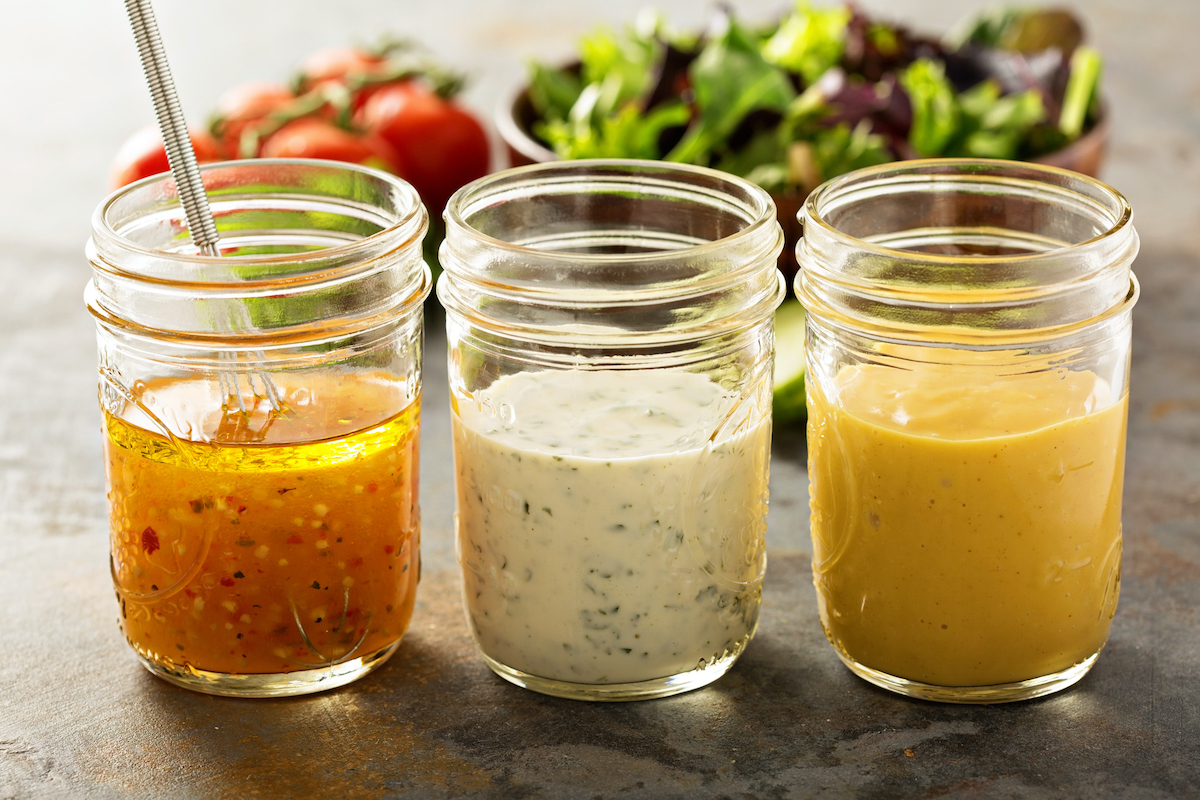Homemade dressings are a must in my opinion! Why? For starters, they taste far better than anything you could buy. Plus, almost all pre-made salad dressings have way too many ingredients, too much sodium, poor quality processed oils, or tons of hidden sugar. Often the salad dressing totally negates the healthy qualities of the very salad that you pour it on.
A fresh homemade dressing, on the other hand, gives you the power to control the extra calories, while also presenting an opportunity to increase nutrition by adding fresh superfoods. Once you master the very simple art of making your own salad dressing, you will never want to buy dressing again! As a plant-based chef, I whip up healthy salad dressings all of the time. Here are some of my favorite tips, techniques, and flavor combinations you can use at home to do the same.
What You’ll Need
A good salad or power bowl dressing can be made out of a number of different staples, or base ingredients – good quality oil (if that’s part of your diet), vinegar, mustard, citrus juice, nuts or nut butters, hummus, tahini, vegan mayo, and even tofu. Fresh garlic is added to almost all of my dressings, so make sure to have a garlic press or microplane on hand. (Fresh garlic helps boost the immune system and delivers antibiotic properties.)
Recommended Equipment
Dressing can be whisked together in a bowl or made in a blender or food processor. Most often I prefer a blender, one of those smaller smoothie blenders, because it does such a good job emulsifying the dressing. If you don’t have a food processor or blender, don’t sweat! You can still whisk your dressings together by hand.
The Perfect Ratio
A great dressing ratio to start with is 3:2:1. Just remember the following:
- 3 parts base ingredient
- 2 parts acid
- 1 part sweetener and/or flavor
Depending on the base ingredient, you may need to add water so the proper consistency is reached – this holds especially true when using nut butters. It is also a good idea to err on the side of less when adding the acid and sweetener, so you aren’t choking on the potency of the dressing. The “3:2:1” is more a helpful memory aid than a very strict guideline.
When you work with a ratio, or formula, you can scale the recipe up or down with ease, depending on your needs at the time. Understanding the very basic concept of what you are doing is essential, in my opinion, in accessing the freedom of tapping into your intuitive chef ability. Personally, I like to make more than what I need so that I have some leftover for the next day or week (batch cooking for the win!).
Dressing keeps just fine in the fridge for at least a week, if not longer. I’ll also always make dressing in a nearly empty mustard jar, so that nothing goes to waste! Just make sure to label it in case you forget that it’s no longer mustard.
How to Make a Homemade Healthy Salad Dressing
Begin with your base, ideally something that needs thinning before it can be drizzled over a salad or power bowl. Next, add an acid such as citrus juice or vinegar – balsamic or white balsamic, apple cider, red or white wine, champagne, raspberry, rice, etc.
Balance this acidity with your healthy sweetener of choice, such as maple syrup, local honey, or fresh or dried fruit.
Finally, finish the dressing with herbs and spices, fresh garlic, or essential oils that are safe for consumption. Spirulina is a great superfood to add to a dressing to up the protein, and add color to your plate – this is really ideal for a creamy dressing, and the spirulina can add a beautiful green or blue hue to the dressing.
Vinaigrettes and Oil-Based Dressings
If you include oils in your diet, such as extra-virgin olive oil, avocado oil, flax, hemp, or walnut oil those follow a similar ratio, except that the acid comes first: 3 parts acid: 2 parts oil: 1 part sweetener. I lean on the side of less than 1 here, because you can always add more to taste.
Get Spicy!
Herbs and spices such as turmeric, dill, smoked paprika, oregano, parsley, cilantro, and cumin have been particularly delicious to add to dressings, so experiment with what you’ve got in your pantry. Sometimes the dressing needs a little salt, or you could opt for tamari, pickle juice, or sauerkraut for a little extra zip and probiotic benefit.
Amazing Flavor Combinations to Try
Try these different combinations to get your creative juices flowing!
- Mustard vinaigrette – dijon, extra virgin olive oil, maple syrup, apple cider vinegar
- Spicy peanut – peanut butter, red curry paste, rice vinegar, tamari, maple syrup
- Lemon garlic tahini – tahini, lemon juice, white wine vinegar, fresh garlic, fresh herbs
- Power greens – hummus, orange juice, spinach, parsley, cilantro or cilantro essential oil
Ginger Almond Dressing Recipe
To get you started, here is one of my favorite recipes from my cookbook, Plant-Based, Vegan, Gluten-Free Cooking with Essential Oils.
Ginger Almond Dressing
- ¼ cup almond butter
- 1 t (teaspoon) tamari
- 2 T (tablespoon) rice vinegar
- ¼ cup water
- 2 drops high-quality, food-grade Ginger essential oil or 1 tsp fresh, grated ginger
Pour this dressing on a cold soba noodle salad, over a bed of crisp greens and citrus fruits, or on top of a plant-based power bowl for extra zing!











Join the GloWell Community on Social!
Don't risk missing a single thing. Follow us on social and become part of the GloWell community.